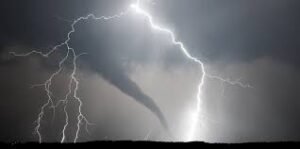What is a Tornado?

A tornado is a rapidly rotating column of air that extends from a thunderstorm to the ground. These violent storms are capable of producing devastating winds, which can reach speeds exceeding 300 miles per hour (482 km/h). Tornadoes are known for their distinctive funnel-shaped clouds and their ability to cause widespread destruction in a short period.
How Do Tornadoes Form?
Tornadoes form under specific atmospheric conditions. The process generally involves the following steps:
- Warm, Moist Air Meets Cool, Dry Air: When warm, moist air from the Gulf of Mexico collides with cool, dry air from Canada, it creates atmospheric instability.
- Wind Shear: Variations in wind speed and direction at different altitudes cause horizontal spinning air currents.
- Updrafts and Thunderstorms: Rising warm air tilts these horizontal currents into a vertical position, forming a rotating updraft known as a mesocyclone.
- Tornado Formation: If the rotation strengthens and extends toward the ground, a tornado forms.
Different Types of Tornadoes
While all tornadoes share similar characteristics, they can be classified into different types:
- Supercell Tornadoes: These are the most dangerous and long-lasting tornadoes, forming from strong thunderstorms known as supercells.
- Landspouts: Typically weaker than supercell tornadoes, landspouts form without a mesocyclone and have a thin, rope-like appearance.
- Waterspouts: Tornadoes that form over bodies of water; they are generally less intense than land tornadoes.
- Gustnadoes: Short-lived tornadoes that form along gust fronts, often appearing weaker and smaller.
- Multiple Vortex Tornadoes: These tornadoes contain multiple rotating vortices within a single parent circulation.

Tornado
Tornado Strength and the Enhanced Fujita Scale (EF Scale)
Tornado intensity is measured using the Enhanced Fujita (EF) Scale, which estimates wind speeds based on the damage caused:
- EF-0 (65-85 mph): Minor damage, such as broken tree branches.
- EF-1 (86-110 mph): Moderate damage, including roof damage and overturned cars.
- EF-2 (111-135 mph): Considerable damage, with houses losing roofs and trees being uprooted.
- EF-3 (136-165 mph): Severe damage, including entire houses being destroyed.
- EF-4 (166-200 mph): Devastating damage with well-built homes being leveled.
- EF-5 (Over 200 mph): Catastrophic damage where entire communities can be wiped out.
Where Do Tornadoes Occur Most Frequently?
Tornadoes occur worldwide, but some regions experience them more frequently:
- United States: Tornado Alley, covering states like Texas, Oklahoma, Kansas, and Nebraska, sees the highest frequency of tornadoes.
- Canada: The second-highest number of tornadoes occurs in Canada, particularly in Alberta, Manitoba, and Saskatchewan.
- Europe: The UK, Germany, and the Netherlands report tornado activity, though typically weaker than in the U.S.
- Australia: Experiences tornadoes mainly in the southeast, but they are less common than in North America.
- Bangladesh & India: Pre-monsoon tornadoes are common, often causing significant destruction.

Tornado Safety: How to Stay Safe Before, During, and After a Tornado
Before a Tornado
- Monitor Weather Alerts: Stay updated via weather apps, NOAA Weather Radio, or news stations.
- Create a Tornado Safety Plan: Identify the safest area in your home, such as a basement or an interior room on the lowest floor.
- Prepare an Emergency Kit: Include essentials such as water, non-perishable food, a flashlight, batteries, a first aid kit, and important documents.
During a Tornado
- If Indoors: Take cover in a small, windowless room or basement. Cover yourself with a mattress or heavy blankets.
- If in a Vehicle: Drive at a right angle to the tornado’s path or abandon the vehicle and find a low-lying area.
- If Outside: Seek shelter in a sturdy building or lie flat in a ditch, covering your head.
After a Tornado
- Check for Injuries: Seek medical assistance if necessary.
- Avoid Downed Power Lines: Stay clear of damaged structures and power lines.
- Report Damage: Notify local authorities about any structural damage or hazards.
Famous Tornadoes in History
Some of the deadliest and most destructive tornadoes include:
- Tri-State Tornado (1925, USA): The deadliest tornado in U.S. history, killing 695 people across Missouri, Illinois, and Indiana.
- Daulatpur-Saturia Tornado (1989, Bangladesh): The deadliest tornado in world history, with approximately 1,300 fatalities.
- Joplin Tornado (2011, USA): An EF-5 tornado that caused 158 deaths and over $2.8 billion in damages.
- Moore Tornado (2013, USA): An EF-5 tornado that devastated Moore, Oklahoma, causing extensive damage.
Climate Change and Tornadoes
Research suggests that climate change may impact tornado patterns in the following ways:
- Increased Frequency: Some studies indicate a rising trend in tornado outbreaks.
- Shifting Tornado Alley: Tornado activity appears to be shifting eastward, affecting states like Mississippi and Alabama more frequently.
- More Severe Storms: Warmer temperatures may contribute to stronger thunderstorms, potentially leading to more intense tornadoes.
Tornado Myths and Misconceptions
1. Tornadoes Cannot Strike Big Cities
Tornadoes have hit large cities, including Oklahoma City, Nashville, and Dallas.
2. Opening Windows Reduces Tornado Damage
This is a myth; opening windows can increase damage by allowing more wind pressure inside.
3. Overpasses are Safe During a Tornado
Seeking shelter under an overpass is dangerous as wind speeds can intensify in such areas.

Conclusion
Tornadoes are among nature’s most powerful and unpredictable phenomena. Understanding how they form, their classifications, and safety measures can help minimize risks and save lives. Staying informed, preparing emergency plans, and following expert advice are crucial steps in mitigating tornado-related dangers.
By gaining more knowledge about tornadoes, communities can be better prepared and resilient against these devastating storms.
